2018 LEXUS LS500 airbag
[x] Cancel search: airbagPage 40 of 514
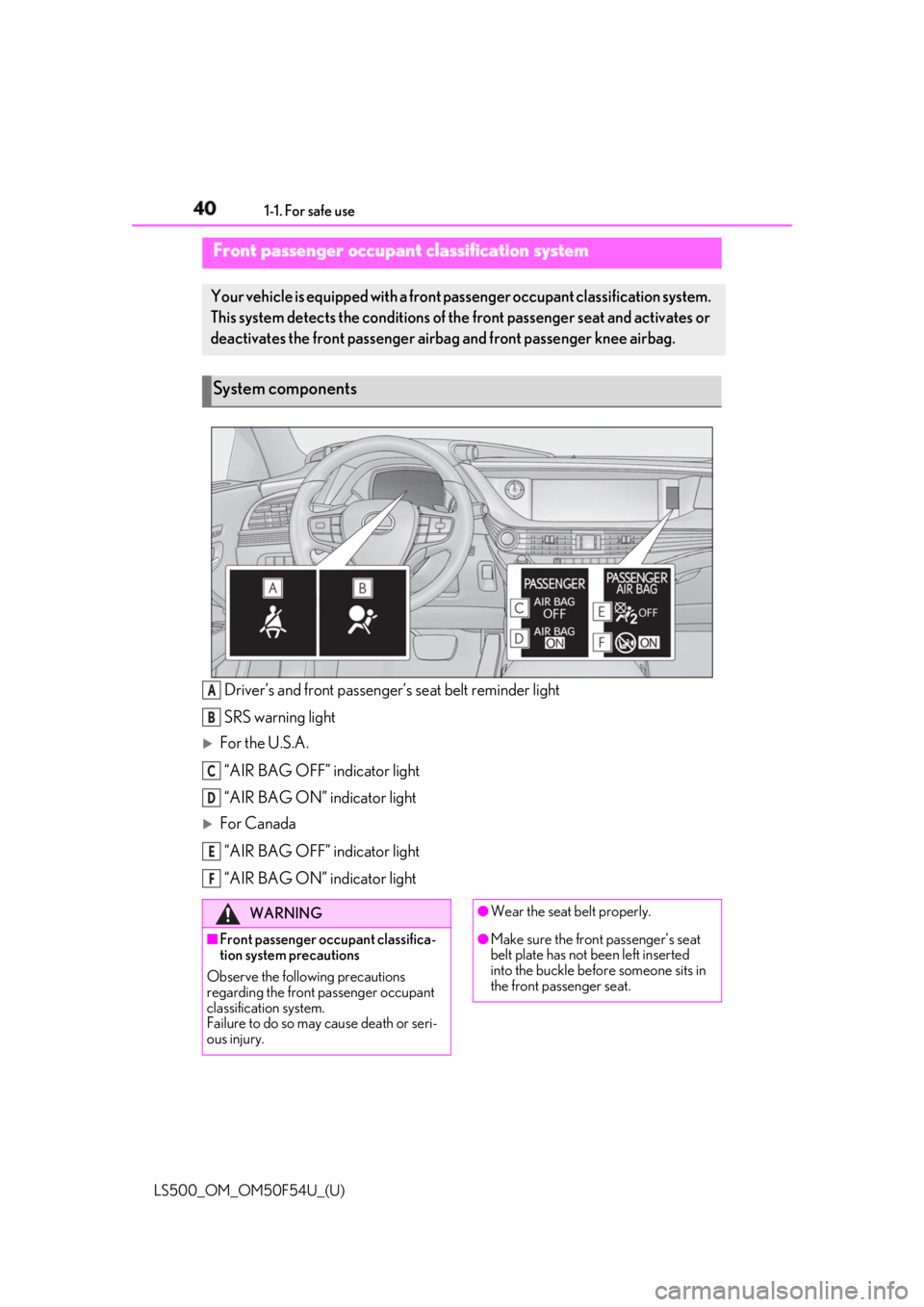
40 1-1. For safe use
LS500_OM_OM50F54U_(U) Driver’s and front passenger’s seat belt reminder light
SRS warning light
For the U.S.A.
“AIR BAG OFF” indicator light
“AIR BAG ON” indicator light
For Canada
“AIR BAG OFF” indicator light
“AIR BAG ON” indicator lightFront passenger occupant classification system Your vehicle is equipped with a front pa ssenger occupant clas sification system.
This system detects the conditions of th e front passenger seat and activates or
deactivates the front passenger airb ag and front passenger knee airbag.
System components
A
B
C
D
E
F
WARNING
■
Front passenger occupant classifica-
tion system precautions
Observe the following precautions
regarding the front passenger occupant
classification system.
Failure to do so may cause death or seri-
ous injury. ●
Wear the seat belt properly.
●
Make sure the front passenger’s seat
belt plate has not been left inserted
into the buckle before someone sits in
the front passenger seat.
Page 41 of 514
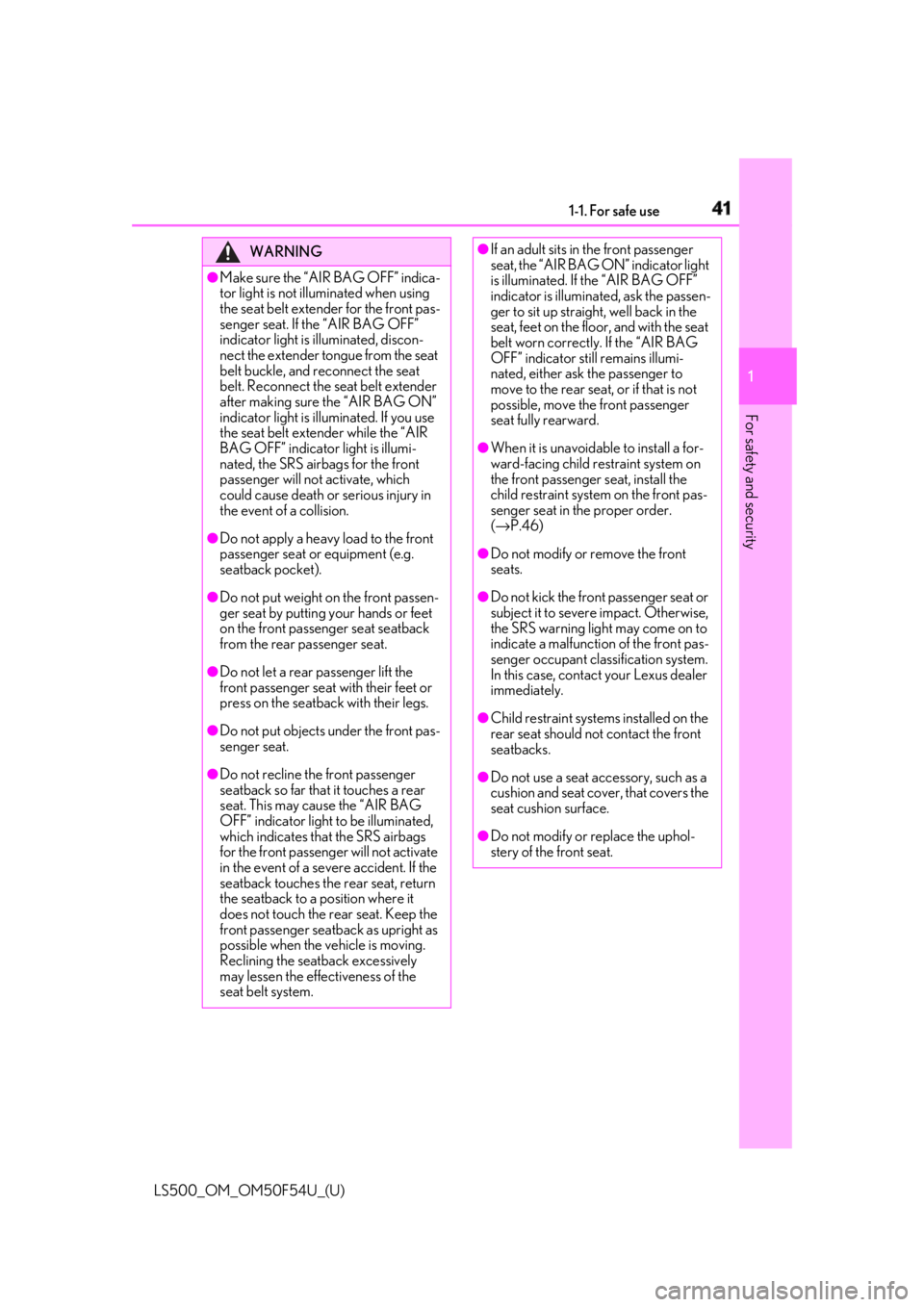
411-1. For safe use
LS500_OM_OM50F54U_(U) 1
For safety and security WARNING●
Make sure the “AIR BAG OFF” indica-
tor light is not illuminated when using
the seat belt extender for the front pas-
senger seat. If the “AIR BAG OFF”
indicator light is illuminated, discon-
nect the extender tongue from the seat
belt buckle, and reconnect the seat
belt. Reconnect the se at belt extender
after making sure the “AIR BAG ON”
indicator light is illu minated. If you use
the seat belt extender while the “AIR
BAG OFF” indicator light is illumi-
nated, the SRS airbags for the front
passenger will not activate, which
could cause death or serious injury in
the event of a collision.●
Do not apply a heavy load to the front
passenger seat or equipment (e.g.
seatback pocket).●
Do not put weight on the front passen-
ger seat by putting your hands or feet
on the front passenger seat seatback
from the rear passenger seat.●
Do not let a rear passenger lift the
front passenger seat with their feet or
press on the seatback with their legs.●
Do not put objects under the front pas-
senger seat.
●
Do not recline the front passenger
seatback so far that it touches a rear
seat. This may cause the “AIR BAG
OFF” indicator light to be illuminated,
which indicates that the SRS airbags
for the front passenger will not activate
in the event of a severe accident. If the
seatback touches the rear seat, return
the seatback to a position where it
does not touch the rear seat. Keep the
front passenger seatback as upright as
possible when the vehicle is moving.
Reclining the seatback excessively
may lessen the effectiveness of the
seat belt system. ●
If an adult sits in the front passenger
seat, the “AIR BAG ON” indicator light
is illuminated. If the “AIR BAG OFF”
indicator is illuminated, ask the passen-
ger to sit up straight, well back in the
seat, feet on the floor, and with the seat
belt worn correctly. If the “AIR BAG
OFF” indicator still remains illumi-
nated, either ask the passenger to
move to the rear seat, or if that is not
possible, move the front passenger
seat fully rearward. ●
When it is unavoidable to install a for-
ward-facing child re straint system on
the front passenger seat, install the
child restraint system on the front pas-
senger seat in the proper order.
( → P.46)●
Do not modify or remove the front
seats. ●
Do not kick the front passenger seat or
subject it to severe impact. Otherwise,
the SRS warning light may come on to
indicate a malfunction of the front pas-
senger occupant clas sification system.
In this case, contact your Lexus dealer
immediately. ●
Child restraint systems installed on the
rear seat should not contact the front
seatbacks.
●
Do not use a seat accessory, such as a
cushion and seat cover, that covers the
seat cushion surface.
●
Do not modify or replace the uphol-
stery of the front seat.
Page 42 of 514
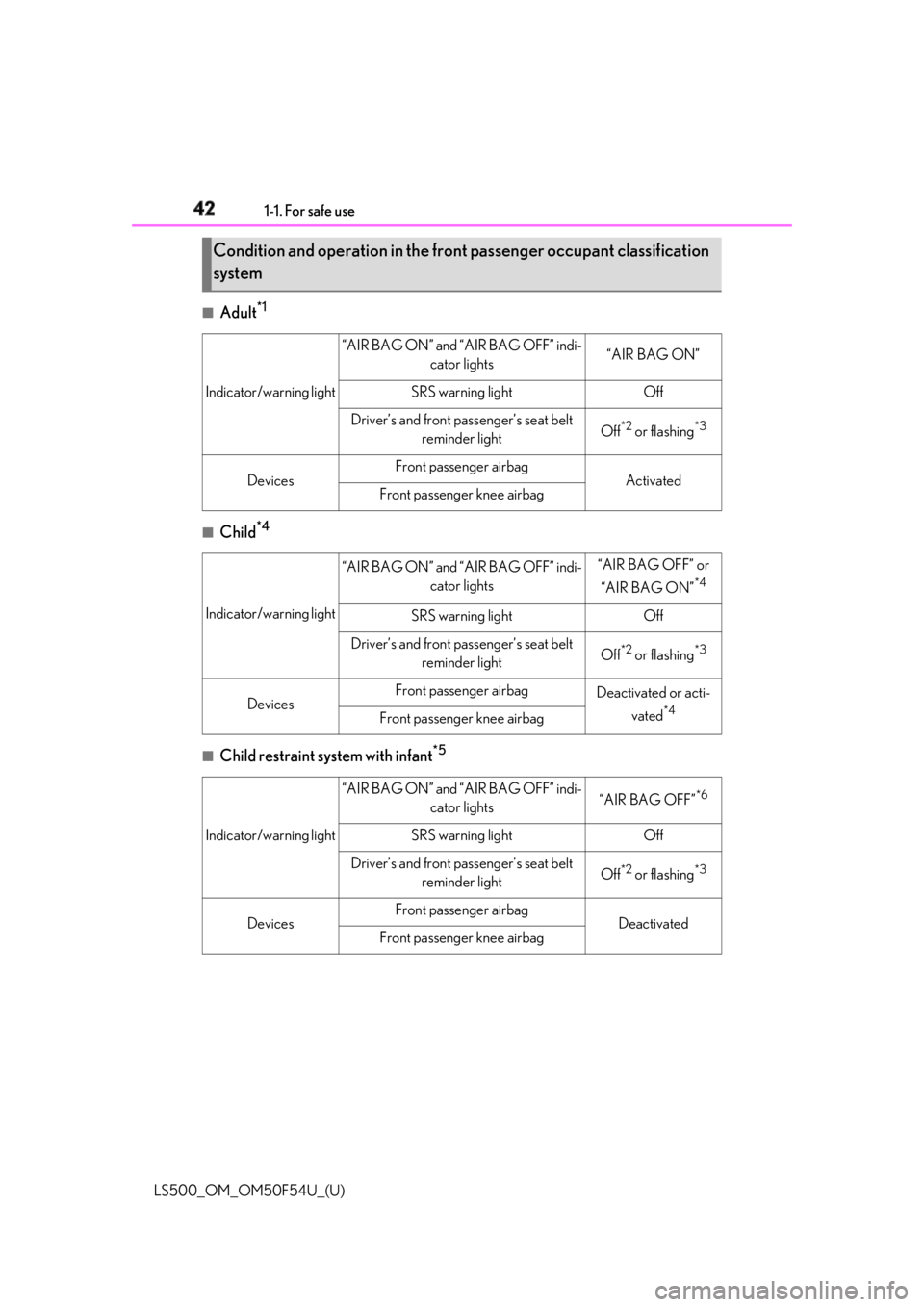
42 1-1. For safe use
LS500_OM_OM50F54U_(U) ■
Adult *1
■
Child *4
■
Child restraint system with infant *5Condition and operation in the front passenger occupant classification
system Indicator/warning light “AIR BAG ON” and “AIR BAG OFF” indi-
cator lights “AIR BAG ON”
SRS warning light Off
Driver’s and front passenger’s seat belt
reminder light Off *2
or flashing *3
Devices Front passenger airbag
Activated
Front passenger knee airbag
Indicator/warning light “AIR BAG ON” and “AIR BAG OFF” indi-
cator lights “AIR BAG OFF” or
“AIR BAG ON” *4
SRS warning light Off
Driver’s and front passenger’s seat belt
reminder light Off *2
or flashing *3
Devices Front passenger airbag
Deactivated or acti-
vated *4
Front passenger knee airbag
Indicator/warning light “AIR BAG ON” and “AIR BAG OFF” indi-
cator lights “AIR BAG OFF” *6
SRS warning light Off
Driver’s and front passenger’s seat belt
reminder light Off *2
or flashing *3
Devices Front passenger airbag
Deactivated
Front passenger knee airbag
Page 43 of 514
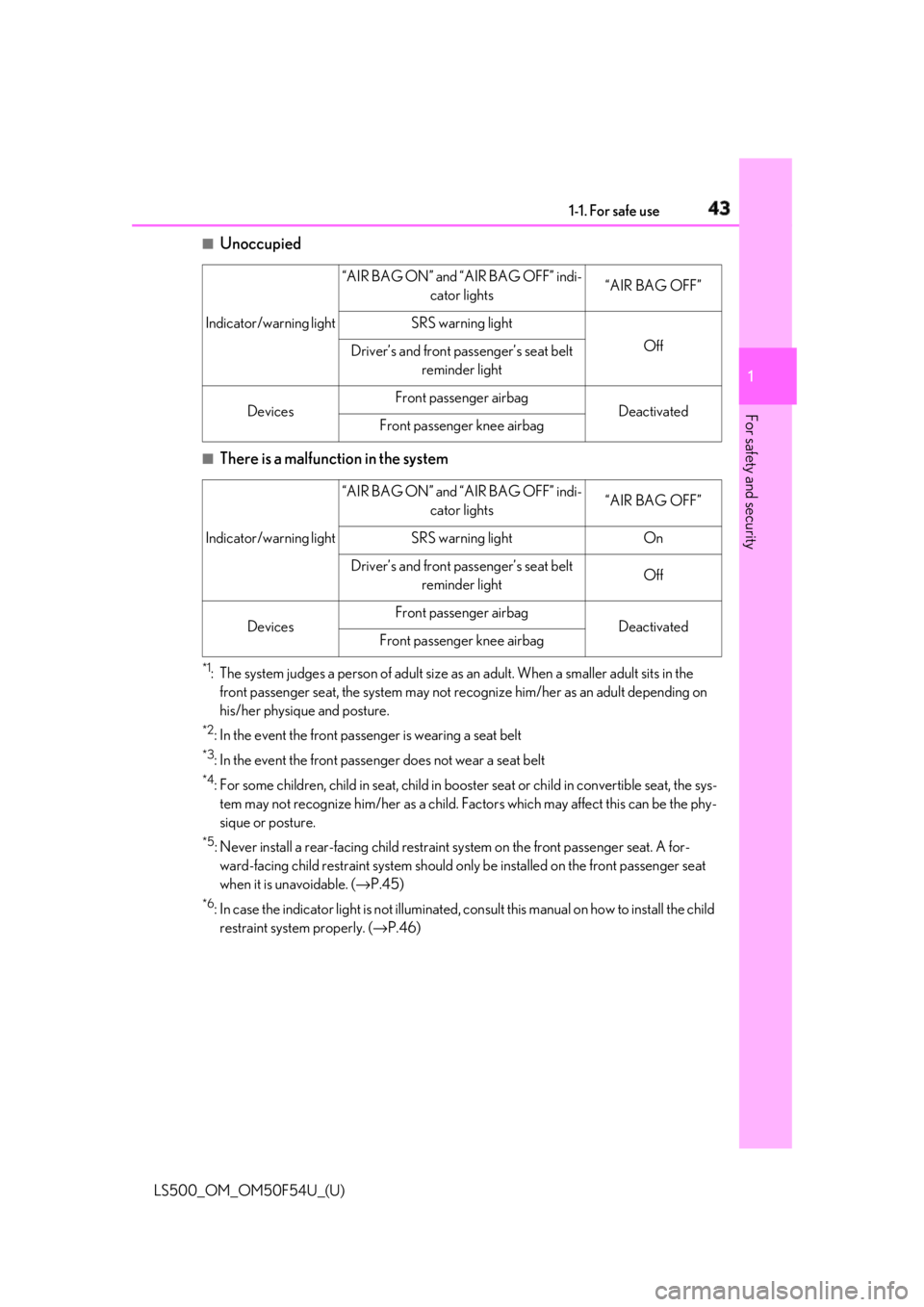
431-1. For safe use
LS500_OM_OM50F54U_(U) 1
For safety and security ■
Unoccupied
■
There is a malfunction in the system *1
: The system judges a person of adult size as an adult. When a smaller adult sits in the
front passenger seat, the system may not re cognize him/her as an adult depending on
his/her physique and posture. *2
: In the event the front passenger is wearing a seat belt *3
: In the event the front passenger does not wear a seat belt *4
: For some children, child in se at, child in booster seat or ch ild in convertible seat, the sys-
tem may not recognize him/her as a child. Factors which may affect this can be the phy-
sique or posture. *5
: Never install a rear-facing child restraint system on th e front passenger seat. A for-
ward-facing child restraint system should only be installed on the front passenger seat
when it is unavoidable. ( → P.45)*6
: In case the indicator light is not illuminated, consult this manual on how to install the child
restraint system properly. ( → P.46)Indicator/warning light “AIR BAG ON” and “AIR BAG OFF” indi-
cator lights “AIR BAG OFF”
SRS warning light
Off
Driver’s and front passenger’s seat belt
reminder light
Devices Front passenger airbag
Deactivated
Front passenger knee airbag
Indicator/warning light “AIR BAG ON” and “AIR BAG OFF” indi-
cator lights “AIR BAG OFF”
SRS warning light On
Driver’s and front passenger’s seat belt
reminder light Off
Devices Front passenger airbag
Deactivated
Front passenger knee airbag
Page 48 of 514
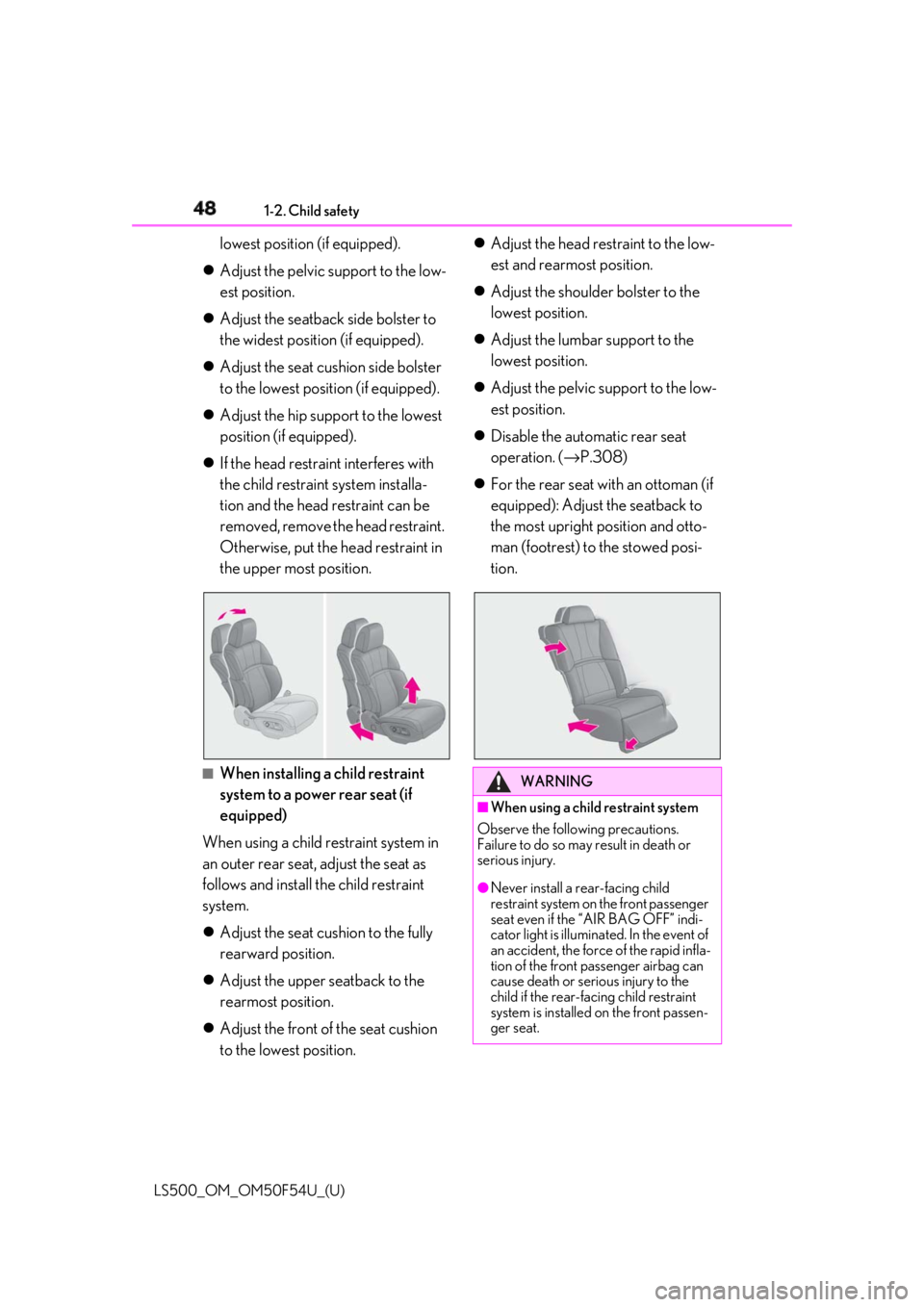
48 1-2. Child safety
LS500_OM_OM50F54U_(U) lowest position (if equipped).
Adjust the pelvic support to the low-
est position.
Adjust the seatback side bolster to
the widest position (if equipped).
Adjust the seat cushion side bolster
to the lowest position (if equipped).
Adjust the hip support to the lowest
position (if equipped).
If the head restraint interferes with
the child restraint system installa-
tion and the head restraint can be
removed, remove the head restraint.
Otherwise, put the head restraint in
the upper most position.
■
When installing a child restraint
system to a power rear seat (if
equipped)
When using a child restraint system in
an outer rear seat, adjust the seat as
follows and install the child restraint
system.
Adjust the seat cushion to the fully
rearward position.
Adjust the upper seatback to the
rearmost position.
Adjust the front of the seat cushion
to the lowest position. Adjust the head restraint to the low-
est and rearmost position.
Adjust the shoulder bolster to the
lowest position.
Adjust the lumbar support to the
lowest position.
Adjust the pelvic support to the low-
est position.
Disable the automatic rear seat
operation. ( → P.308)
For the rear seat with an ottoman (if
equipped): Adjust the seatback to
the most upright position and otto-
man (footrest) to the stowed posi-
tion.
WARNING
■
When using a child restraint system
Observe the following precautions.
Failure to do so may result in death or
serious injury.
●
Never install a rear-facing child
restraint system on the front passenger
seat even if the “AIR BAG OFF” indi-
cator light is illuminated. In the event of
an accident, the force of the rapid infla-
tion of the front passenger airbag can
cause death or serious injury to the
child if the rear-fac ing child restraint
system is installed on the front passen-
ger seat.
Page 49 of 514
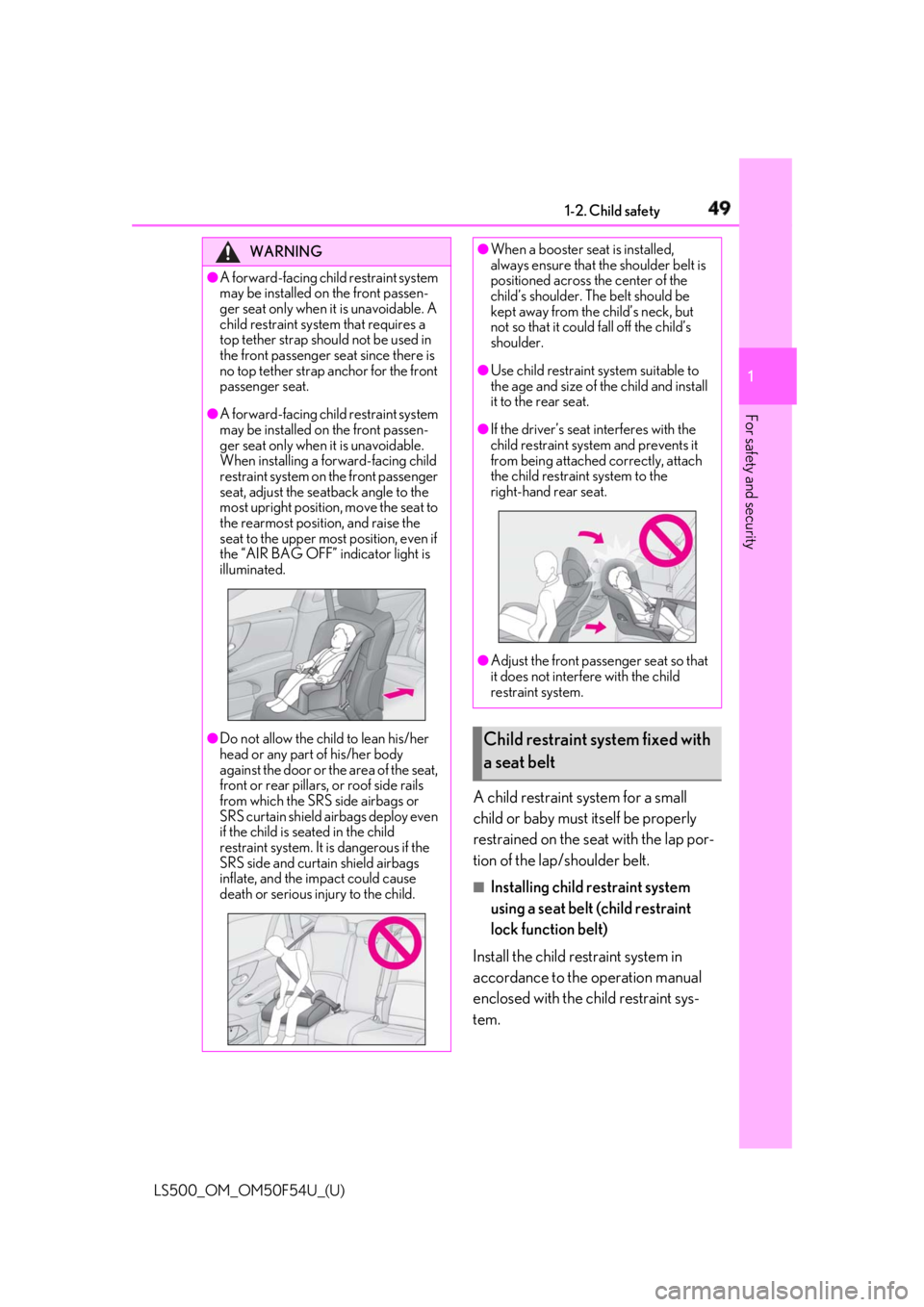
491-2. Child safety
LS500_OM_OM50F54U_(U) 1
For safety and security
A child restraint system for a small
child or baby must itself be properly
restrained on the seat with the lap por-
tion of the lap/shoulder belt. ■
Installing child restraint system
using a seat belt (child restraint
lock function belt)
Install the child restraint system in
accordance to the operation manual
enclosed with the child restraint sys-
tem.WARNING●
A forward-facing child restraint system
may be installed on the front passen-
ger seat only when it is unavoidable. A
child restraint system that requires a
top tether strap should not be used in
the front passenger seat since there is
no top tether strap anchor for the front
passenger seat.●
A forward-facing child restraint system
may be installed on the front passen-
ger seat only when it is unavoidable.
When installing a forward-facing child
restraint system on the front passenger
seat, adjust the seatback angle to the
most upright position, move the seat to
the rearmost position, and raise the
seat to the upper most position, even if
the “AIR BAG OFF” indicator light is
illuminated.
●
Do not allow the child to lean his/her
head or any part of his/her body
against the door or the area of the seat,
front or rear pillars, or roof side rails
from which the SRS side airbags or
SRS curtain shield ai rbags deploy even
if the child is seated in the child
restraint system. It is dangerous if the
SRS side and curtain shield airbags
inflate, and the impact could cause
death or serious injury to the child. ●
When a booster seat is installed,
always ensure that th e shoulder belt is
positioned across the center of the
child’s shoulder. The belt should be
kept away from the child’s neck, but
not so that it could fall off the child’s
shoulder. ●
Use child restraint system suitable to
the age and size of the child and install
it to the rear seat. ●
If the driver’s seat interferes with the
child restraint system and prevents it
from being attached correctly, attach
the child restraint system to the
right-hand rear seat.
●
Adjust the front passe nger seat so that
it does not interfere with the child
restraint system.
Child restraint system fixed with
a seat belt
Page 294 of 514

294 4-5. Using the driving support systems
LS500_OM_OM50F54U_(U) ■
ECB (Electronically Controlled
Brake System) (if equipped)
The electronically controlled system
generates braking force correspond-
ing to the brake operation ■
ABS (Anti-lock Brake System)
Helps to prevent wheel lock when the
brakes are applied suddenly, or if the
brakes are applied while driving on a
slippery road surface ■
Brake assist
Generates an increased level of brak-
ing force after the brake pedal is
depressed when the system detects a
panic stop situation ■
VSC (Vehicle Stability Control)
Helps the driver to control skidding
when swerving sudden ly or turning on
slippery road surfaces. ■
Secondary Collision Brake
When the airbag sensor detects a colli-
sion, the brakes and brake lights are
automatically controlled to reduce the vehicle speed and that helps reduce
the possibility of further damage due to
a secondary collision. ■
TRAC (Traction Control)
Helps to maintain drive power and pre-
vent the drive wheels from spinning
when starting the vehicle or accelerat-
ing on slippery roads ■
Hill-start assist control
Helps to reduce the backward move-
ment of the vehicle when starting on an
uphill ■
VGRS (Variable Gear Ratio Steer-
ing) (if equipped)
Adjusts the front wheel turning angle in
accordance with the vehicle speed and
steering wheel movement ■
DRS (Dynamic Rear Steering) (if
equipped)
Contributes to the turning characteris-
tics and responsiveness of the vehicle
by adjusting the rear wheel angle of the
vehicle in accordance with steering
wheel movement. ■
EPS (Electric Power Steering)
Employs an electric motor to reduce
the amount of effort needed to turn the
steering wheel. ■
Active stabilizer suspension sys-
tem (if equipped)
Reduces sway when cornering accord-
ing to steering wheel movement in
order to maintain a stable vehicle pos-
ture.Driving assist systems To keep driving safety and perfor-
mance, the following systems oper-
ate automatically in response to
various driving situations. Be aware,
however, that these systems are
supplementary and should not be
relied upon too heavily when oper-
ating the vehicle.
Summary of the driving assist
systems
Page 297 of 514

2974-5. Using the driving support systems
LS500_OM_OM50F54U_(U) 4
Driving • Vehicles without Lexus Safety Sys-
tem+A: The brake pedal may move down
slightly after the ABS is activated.■
ECB operating sound
ECB operating sound may be heard in the
following cases, but it does not indicate that
a malfunction has occurred. ●
Operating sound heard from the engine
compartment when the brake pedal is
operated.●
Motor sound of the brake system heard
from the front part of the vehicle when
the driver’s door is opened.●
Operating sound heard from the engine
compartment when one or two minutes
passed after the stop of the engine.■
EPS, VGRS and DRS operation sound
When the steering wheel is operated, a
motor sound (whirring sound) may be
heard. This does not indicate a malfunction. ■
Automatic reactivation of TRAC and
VSC systems
After turning the TRAC and VSC systems
off, the systems will be automatically
re-enabled in the following situations: ●
When the engine switch is turned off●
If only the TRAC system is turned off, the
TRAC will turn on when vehicle speed
increases
If both the TRAC and VSC systems are
turned off, automatic re-enabling will not
occur when vehicle speed increases.■
Reduced effectiveness of the EPS sys-
tem
The effectiveness of the EPS system is
reduced to prevent the system from over-
heating when there is frequent steering
input over an extended period of time. The
steering wheel may feel heavy as a result.
Should this occur, re frain from excessive
steering input or stop the vehicle and turn
the engine off. The EPS system should
return to normal within 10 minutes.
■
Secondary Collision Brake operating
conditions
The vehicle speed is approximately 6 mph
(10 km/h) or more and the airbag sensor detects a collision. (The Secondary Colli-
sion Brake will not operate when the vehicle
speed is below approximately 6 mph [10
km/h].) ■
Secondary Collision Brake automatic
cancellation
The Secondary Collision Brake is automati-
cally canceled in the following situations: ●
The vehicle speed drops below approxi-
mately 6 mph (10 km/h) ●
A certain amount of time elapses during
operation ●
The accelerator pedal is depressed a
large amount ■
When “Check VGRS System” or
“CHECK DRS” is displayed on the
multi-information display
The VGRS or DRS may not operate prop-
erly. Have the vehicle inspected by your
Lexus dealer.
WARNING■
The ABS does not operate effectively
when ●
The limits of tire gripping performance
have been exceeded (such as exces-
sively worn tires on a snow covered
road).
●
The vehicle hydroplanes while driving
at high speed on wet or slick roads.
■
Stopping distance when the ABS is
operating may exceed that of normal
conditions
The ABS is not designed to shorten the
vehicle’s stopping di stance. Always main-
tain a safe distance from the vehicle in
front of you, especially in the following
situations:
●
When driving on dirt, gravel or
snow-covered roads
●
When driving with tire chains
●
When driving over bumps in the road
●
When driving over roads with potholes
or uneven surfaces